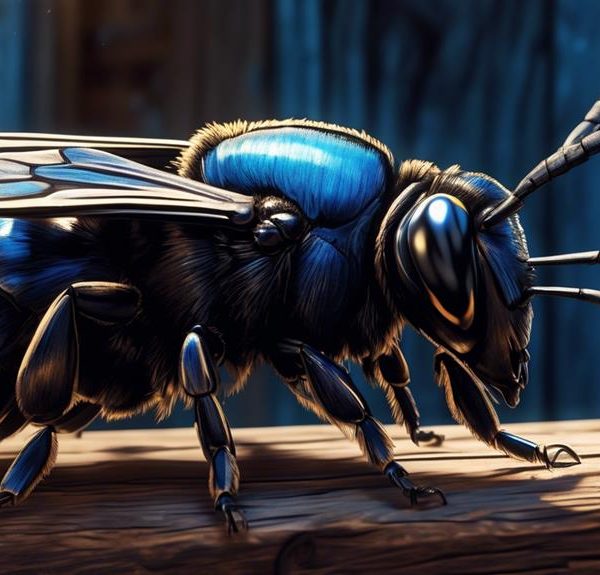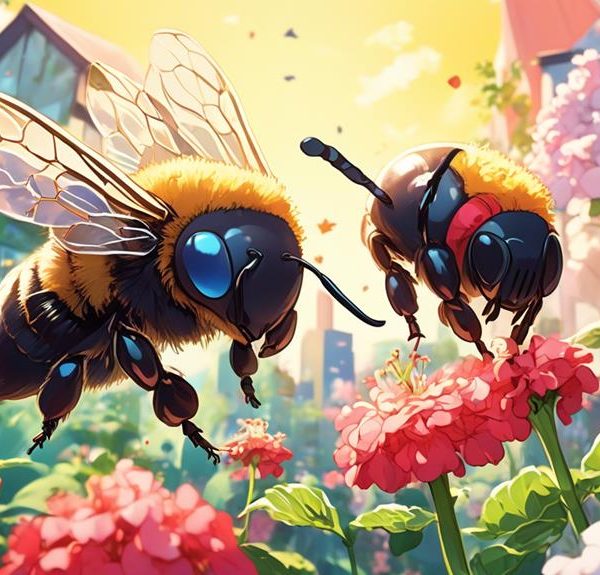Immerse yourself in the intriguing world of the Eastern Carpenter Bee, a creature whose scientific name and vital ecological role are equally fascinating.
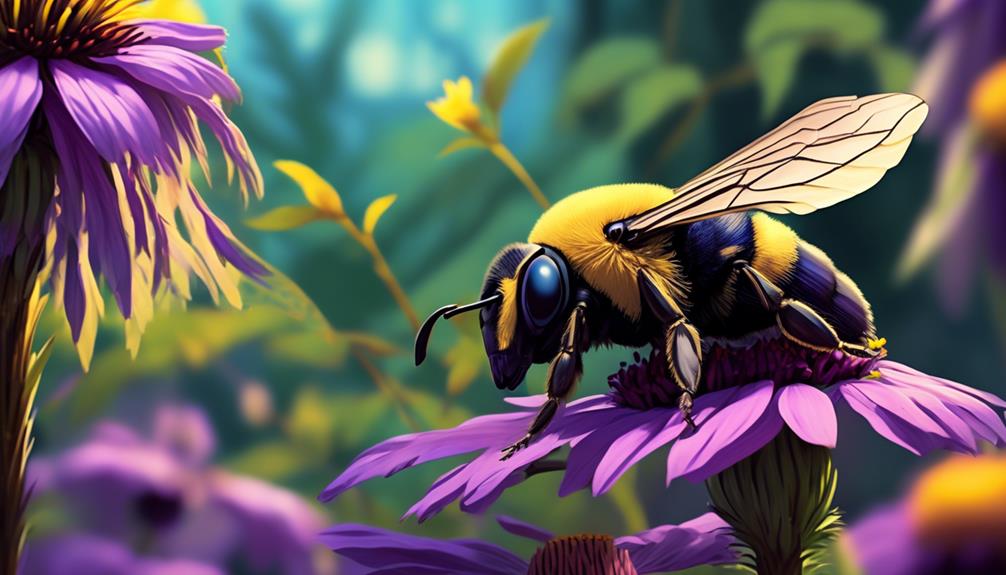
Eastern Carpenter Bee Scientific Name
Don't you just adore it when a creature is so extraordinary that it takes a name that sounds like it belongs in a sci-fi movie? That's precisely the case with the Eastern Carpenter Bee, or as the science world elegantly dubs it, Xylocopa virginica.
As you dive into the wonders of this impressively named species, you'll find its characteristics, behavior, and role in the ecosystem are as intriguing as its title.
But why should you care about a bee, especially one with such an elaborate name? Well, let's just say their impact on our daily lives is more significant than you might initially think.
Stick around, and you'll soon find out why.
Key Takeaways
- The scientific name of the Eastern Carpenter Bee is Xylocopa virginica.
- It belongs to the Order Hymenoptera and the family Apidae.
- The species identifier 'virginica' indicates its prevalence in Virginia.
- The physical characteristics of Xylocopa virginica include a robust body, a metallic blue-black color with a shiny and hairless abdomen, and a distinctive yellow patch on the face of males.
Understanding the Eastern Carpenter Bee
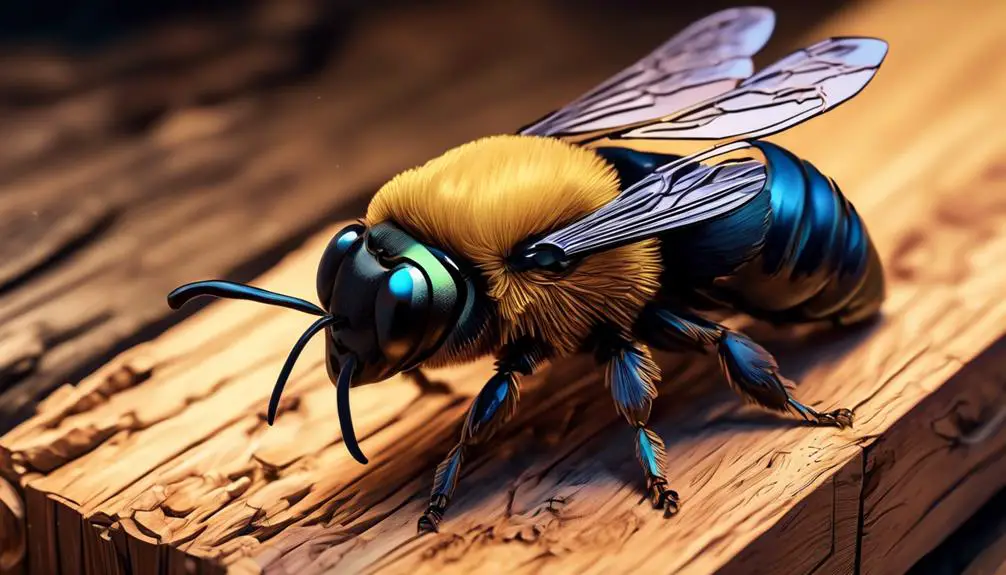
To fully understand the Eastern Carpenter Bee (Xylocopa virginica), you'll need to delve into its unique characteristics, behaviors, and ecological role.
This bee species is distinctive due to its large size, reaching up to 1 inch in length, and its black metallic body, with males sporting a yellow face patch. Uniquely, these bees possess strong mandibles, enabling them to burrow into wood and create nests for their offspring.
Their behavior, you'll find, is quite interesting. Unlike honeybees that live in colonies, Eastern Carpenter Bees are solitary. Each female constructs her own nest, laying her eggs in a series of cells stocked with pollen and nectar. Males, though they appear aggressive, can't sting and their territorial antics are merely for show.
Regarding their ecological role, it's multifaceted. These bees are vital pollinators, transferring pollen from male to female flower parts as they forage for nectar. They're known to 'cheat' by nectar robbing, but even this behavior contributes to the ecosystem by promoting genetic diversity among flowers.
In essence, understanding the Eastern Carpenter Bee means recognizing their integral role in our environment.
Scientific Classification of Xylocopa Virginica
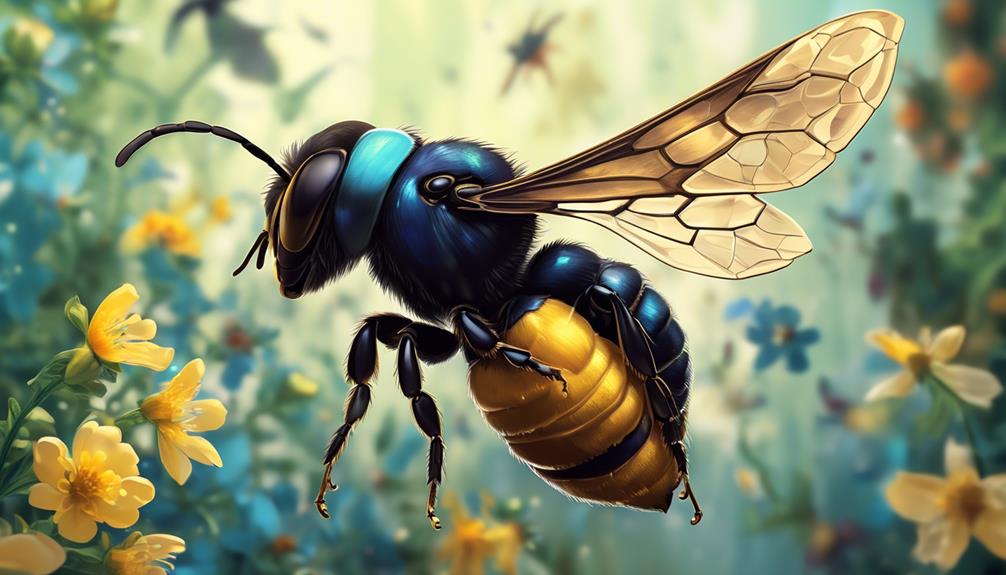
Delving into the realm of scientific classification, you'll find that the Eastern Carpenter Bee, or Xylocopa virginica, belongs to a complex hierarchy within the insect kingdom. As you might expect from its common name, this bee falls within the Order Hymenoptera, which encompasses ants, bees, wasps, and sawflies.
Digging deeper, you'll find that the Eastern Carpenter Bee is part of the family Apidae. This family, known for its diversity, includes honeybees, bumblebees, and stingless bees, among others. Further down the classification ladder, Xylocopa virginica belongs to the genus Xylocopa. This genus, often referred to as the large carpenter bees, boasts about 500 species worldwide.
Let's narrow it down further to the species level. The species identifier 'virginica' signifies this bee's prevalence in Virginia, although its range extends throughout the Eastern U.S. In scientific terms, 'Xylocopa virginica' encapsulates this species' unique identity.
Through this classification, you can see the Eastern Carpenter Bee's place in the natural world, from its close relation to other bees to its distinct characteristics. Understanding this hierarchy helps you appreciate the complexity and diversity of life on Earth.
Physical Characteristics of Xylocopa Virginica
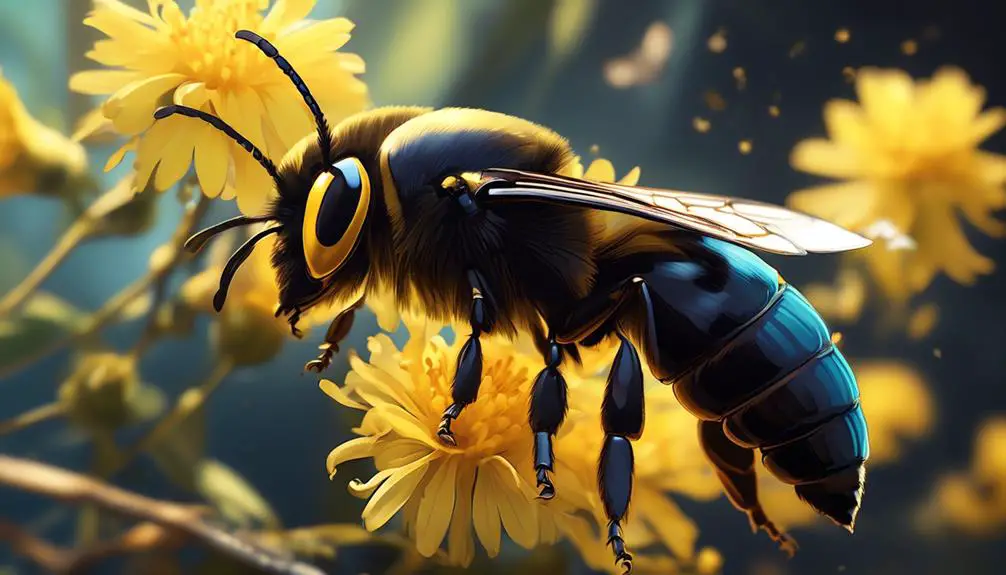
Having examined the Eastern Carpenter Bee's scientific classification, let's now explore its physical characteristics, which distinguish it within the insect kingdom.
The Eastern Carpenter Bee, or Xylocopa virginica, boasts a robust, bumblebee-like body, typically measuring 12 to 25 mm in length. It's the males that sport a distinctive yellow patch on their face, while females are entirely black.
Their bodies, often mistaken for bumblebees, are metallic blue-black with a sheen under sunlight. However, the crucial difference lies in their abdomen. Unlike the fuzzy abdomen of bumblebees, the Eastern Carpenter Bee's abdomen is shiny and hairless.
Here's a quick comparison:
Characteristic | Eastern Carpenter Bee | Bumblebee |
|---|---|---|
Body Color | Metallic Blue-Black | Yellow and Black |
Abdomen | Shiny and Hairless | Fuzzy |
Facial Markings | Males have Yellow Patch | No distinct markings |
These physical attributes not only differentiate the Eastern Carpenter Bee from other bees but also play a crucial role in their survival. For instance, their robust body allows them to bore into wood where they nest and lay their eggs. Thus, these characteristics are not just for show but serve a practical purpose.
Habitat and Distribution of Eastern Carpenter Bees
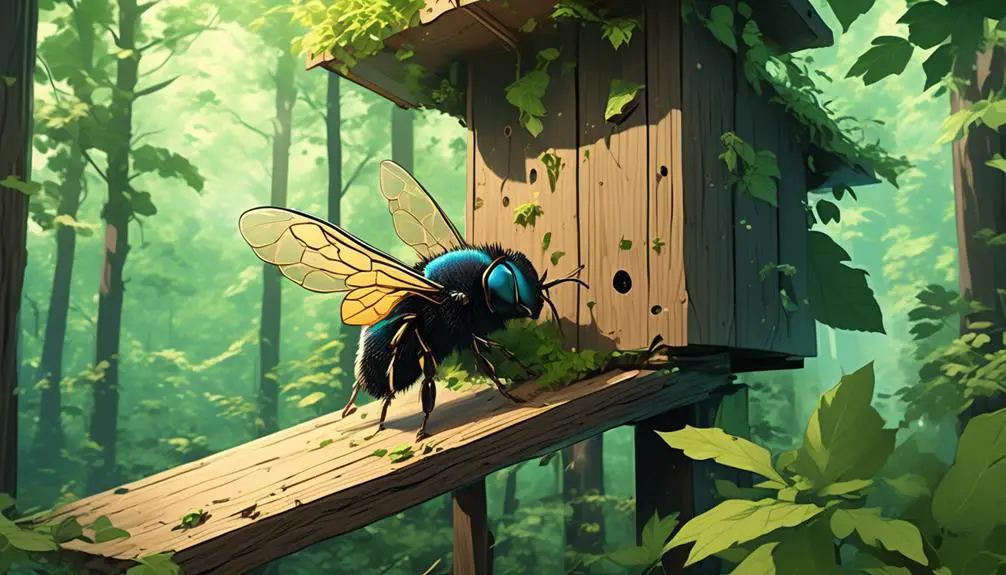
In the vast expanse of North America, you'll find Eastern Carpenter Bees carving a niche for themselves, inhabiting a range stretching from the Atlantic to the Rocky Mountains and from Southern Canada to Northern Mexico. They're well adapted to a variety of environments, but they show a particular preference for deciduous forests and urban areas where wooden structures are abundant.
These bees have a knack for exploiting human-made structures, utilizing untreated or weathered wood for nesting. They're not choosy, though. You'll find them in various types of wood, from pine to oak and everything in between. They're especially fond of structures with a bit of wear and tear, as this makes the wood easier to burrow into.
Their distribution isn't random. It's dictated by the availability of suitable nesting sites and food sources. They're pollinators by nature, so areas rich in flowering plants, particularly those that bloom in the spring and summer, are prime real estate for these bees. So, if you're looking to spot some Eastern Carpenter Bees, you'd do well to pay attention to these regions and habitats.
Their distribution and adaptive behavior is a testament to their resilience and resourcefulness in the face of environmental variations.
Role of Eastern Carpenter Bees in Ecosystem
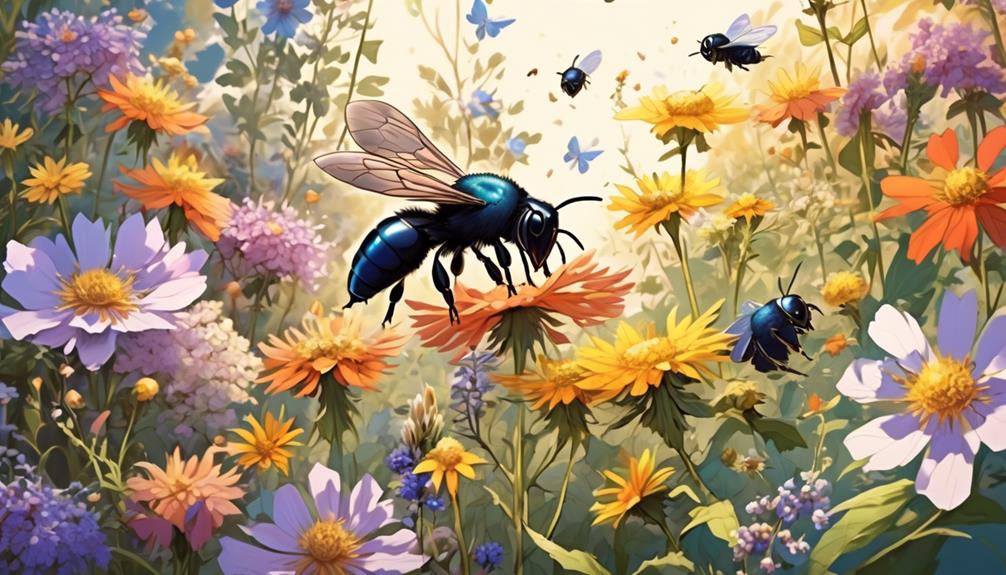
You mightn't realize it, but Eastern Carpenter Bees play a critical role in their ecosystems, primarily through their pollination activities. They're nature's unsung heroes, transferring pollen from the male parts of a flower to the female parts, facilitating plant reproduction. This process is vital for the survival of many plant species, and by extension, the animals that rely on those plants for food and shelter.
Eastern Carpenter Bees are particularly adept pollinators. Unlike honeybees that wet pollen to carry it on their hind legs, Carpenter Bees carry dry pollen on their hairy bodies, unintentionally dusting each flower they visit with a sprinkling of life. They've a penchant for 'buzz pollination', a process where they vibrate their bodies at a specific frequency to dislodge pollen. This method is especially effective for plants that hold their pollen tightly, such as tomatoes and eggplants.
As secondary cavity nesters, they also contribute to biodiversity by creating homes in dead trees and wooden structures, which can then be used by other species. Their ecological role extends beyond pollination. So, don't underestimate these industrious insects. Their work is indispensable to our ecosystems.
Conclusion
In conclusion, you've uncovered the intriguing world of the Eastern Carpenter Bee, Xylocopa virginica. You've learned its distinguishing physical traits, wide distribution, and the vital role it plays in our ecosystem.
This knowledge brings a new appreciation for these often misunderstood creatures. It's a testament to the complexity of nature and our responsibility to understand and protect it.
So, next time you spot a Carpenter Bee, remember, there's more than meets the eye.

